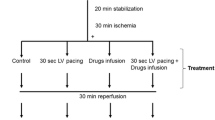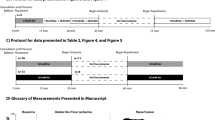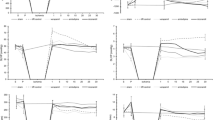Abstract
Reperfusion of hearts with a Ca2+-containing medium after a perfusion period in Ca2+-free medium results in irreversible cell damage (calcium paradox). In this investigation we have studied coronary flow and cyclic AMP and cyclic GMP levels after several periods of Ca2+-free perfusion in isolated rat hearts. We also investigated the effects of papaverine (Pap), noradrenaline (NA), acetylcholine (ACh) and absence of inorganic phosphate during Ca2+-free perfusion on coronary flow (CF) and cyclic nucleotide levels. Inability of the heart to recover contractile activity with development of contracture during the reperfusion period was accepted as indicative of the calcium paradox. Ca2+-free perfusion alone and NA and absence of inorganic phosphate during the Ca2+-free perfusion period increased CF, whereas Pap and ACh decreased it. However, only Ca2+-free perfusion and NA elevated cyclic AMP. On the other hand, Pap and ACh increased cyclic GMP (with a transient rise of cyclic AMP in Pap infusion), and absence of inorganic phosphate decreased both cyclic AMP and cyclic GMP. Pap, ACh and absence of phosphate prevented the calcium paradox. Our study suggests that increased cyclic AMP during the Ca2+-free perfusion may contribute, with the other factors, to the occurrence of the calcium paradox.
Similar content being viewed by others
References
Alto LE, Dhalla LS (1979) Myocardial cation contents during induction of calcium paradox. Am J Physiol 237:H713-H719
Borle AB (1974) Cyclic AMP stimulation of calcium efflux from kidney, liver and heart mitochondria. J Membr Biol 16:221–236
Bricknel OL, Opie LH (1978) Effects of substrates on tissue metabolic changes in the isolated rat heart during under-perfusion and on release of lactate dehidrogenase and arrhytmias during reperfusion. Circ Res 43:102–115
Buxton ILO, Brunton LL (1986) α-Adrenergic receptors on rat ventricular myocytes: characteristics and linkage to cAMP metabolism. Am J Physiol 251:H 307-H 313
Dobson JG Jr (1981) The effects of acetylcholine, ischemia and anoxia on rat heart purine cyclic nucleotides and contractility. Circ Res 49:912–922
Dobson JG Jr, Ordway RW, Fenton RA (1986) Endogenous adenosine inhibits catecholamine contractile responses in normoxic hearts. Am J Physiol 251:H455-H462
Drummond GI, Severson DL (1979) Brief review: cyclic nucelotides and cardiac function. Circ Res 44:145–153
Gardner RM, Allen DE (1977) The relationship between cyclic nucleotide levels and glycogen phosphorylase activity in isolated rat hearts perfused with epinephrine and acetylcholine. J Pharmacol Exp Ther 202:346–353
Gilman AG (1970) A protein binding assay for adenosine 3′,5′-cyclic monophosphate. Proc Natl Acad Sci USA 67:305–312
Harary I, Renaud JF, Sato E, Wallace GA (1976) Calcium ions regulate cyclic AMP and beating in cultured heart cells. Nature 261:60–61
Hartzell HC, Fischmeister R (1986) Opposite effects of cyclic GMP and cyclic AMP on Ca2+ current in single heart cells. Nature 323:273–275
Holzmann S, Mainertz T, Nawrath H, Scholz H (1977) Effect of papaverine on cyclic AMP, calcium uptake and force of contraction in isolated guinea-pig auricles. Res Commun Chem Pathol Pharmacol 16:443–450
Jacobs KH, Saur W, Schultz G (1976) Reduction of adenylate cyclase activity in lysates of human platelets by the alphaadrenergic component of epinephrine. J Cycl Nucl Res 2:381–392
Jacobs KH, Aktories K, Schultz G (1979) GPT dependent inhibition of cardiac adenylate cyclase by muscarinic cholinergic agonists. Naunyn-Schmiedeberg's Arch Pharmacol 310:113–119
Karakullukçu YE, Gökhan N (1982) The influence of verapamil and papaverine on the occurence of the calcium paradox in the isolated rat heart. IRCS Med Sci 10:723–724
Koomen JM, Jagger LP, van Noordwijk J (1980) Effect of perfusion pressure on coronary flow, myocardial calcium washout, and the occurence of calcium paradox in isolated perfused rat heart ventricles. Basic Res Cardiol 75:318–327
Krichberger MA, Tada M, Katz AM (1974) Adenosine 3′∶5′ monophosphate-dependent protein kinase-catalyzed phosphorylation reaction and its relationship to calcium transport in cardiac sarcoplasmic reticulum. J Biol Chem. 249:6166–6173
Kukowetz WR, Holzmann S, Wurm A, Pöch G (1979) Evidence for cyclic GMP-mediated relaxant effect of nitro-compounds in coronary smooth muscle. Naunyn-Schmiedeberg's Arch Pharmacol 310:129–137
Lamers JMJ, Stinis TJ, Ruigrok TJC (1984) Biochemical properties of membranes isolated from calcium-depleted hearts. Circ Res 54:217–226
Langendorff O (1895) Untersuchungen am überlebenden Säugetierherzen. Pflügers Arch 61:291–332
Lehninger AL (1970) Mitochondria and calcium ion transport. Biochem J 119:129–138
Limas CJ, Notargiacomo AV, Cohn NJ (1973) Effect of cyclic 3′∶5′-AMP on the (Na-K)-ATPase of myocardial sarcolemma. Cardiovase Res 7:477–481
Martona PA (1971) The role of cyclic AMP in isoprenaline-induced cardiac necroses in the rat. J Pharm Pharmacol 23:200–203
Murad F (1986) Cyclic guanosine monophosphate as a mediator of vasodilation (Perspectives). J Clin Invest 78:1–5
Murad F, Manganiello V, Vaughan M (1971) A simple sensitive protein-binding assay for guanosine 3′∶5′ monophosphate. Proc Natl Acad Sci USA 68:736–739
Neely JR, Libermeister H, Battersby EJ, Morgan EH (1967) Effect of pressure development on oxygen consumption by isolated rat heart. Am J Physiol 212:804–814
Opie LH (1979) Metabolism, enzyme release, and cell death: possibilities for future investigation. In: Hearse DJ, de Leiris J (eds) Enzymes in cardiology: Diagnosis and research, chapter 24. Wiley, New York, p 561
Øksendal NA, Jynge P, Sellevold OFM, Rotevatn S, Saetersdal T (1985) The calcium paradox phenomenon: a flow rate and volume response study of calcium-free perfusion. J Mol Cell Cardiol 17:959–972
Rardon DP, Pappano AJ (1986) Carbachol inhibits electrophysiological effect of cAMP in ventricular myocytes. Am J Physiol 251:H601-H611
Rona G, Chappel CI, Balazs T, Gaudry R (1959) An infarct like myocardial lesion and other toxic manifestation produced by isoproterenol in the rat. Arch Pathol 67:443–455
Ruigrok TJC, Zimmerman ANE (1979) The effect of calcium on myocardial tissue damage and enzyme release. In: Hearse DJ, de Leiris J (eds) Enzymes in cardiology: Diagnosis and research, chapt 17. Wiley, New York, p 399
Sakanashi M (1981) Pharmacological aspects of coronary arterial spasm. Trends Pharmacol Sci 2:234–235
Schneider JA, Brooker G, Sperelakis N (1975) Short communications. Papaverine blockade of an inward slow Ca2+ current in Guinea pig heart. J Mol Cell Cardiol 7:867–876
Schrader J, Baumann G, Gerlach E (1977) Adenosine as inhibitor of myocardial effects of catecholamines. Pflügers Arch 372:29–35
Sperelakis N (1984) Cyclic AMP and phosphorylation in regulation of Ca2+ influx into myocardial cells and blockade by calcium antagonistic drugs. Am Heart J 107:347–357
Tada M, Katz AM (1982) Phosphorylation of the sarcoplasmic reticulum and sarcolemma. Annu Rev Physiol 44:401–423
Ten Eick R, Nawrtah H, McDonald TF, Trautwein W (1976) On the mechanism of the negative inotropic effect of acetylcholine. Pflügers Arch 361:207–213
Watanabe AM, Besch HR Jr (1974) Cyclic adenosine monophosphate modulation of slow calcium influx channels in guinea pig hearts. Circ Res 35:317–324
Watanabe AM, Besch HR Jr (1975) Interaction between cyclic adenosine monophosphate and cyclic guanosine monophosphate in guinea pig ventricular myocardium. Circ. Res. 37:309–317
Zelis R (1983) Mechanism of vasodilation. First North American Conference on Nitroglycerin Therapy: perspective and mechanism. Am J Med 78:1–12
Zimmerman ANE, Hülsmann WC (1966) Paradoxical influence of calcium ions on the permeability of the cell membranes of the isolated rat heart. Nature 211:646–647
Zimmerman ANE, Deams W, Hülsmann WC, Snijder J, Wisse E, Durrer D (1967) Morphological changes of heart muscle caused by successive perfusion with calcium-free and calcium containing solutions (calcium paradox). Cardiovasc Res 1:201–209
Author information
Authors and Affiliations
Rights and permissions
About this article
Cite this article
Karakullukçu, Y.E., Özçelik, T. & Gökhan, N. Changes in cyclic nucleotides during the calcium paradox in the isolated rat heart. Pflugers Arch. 410, 657–663 (1987). https://doi.org/10.1007/BF00581328
Received:
Revised:
Accepted:
Issue Date:
DOI: https://doi.org/10.1007/BF00581328




